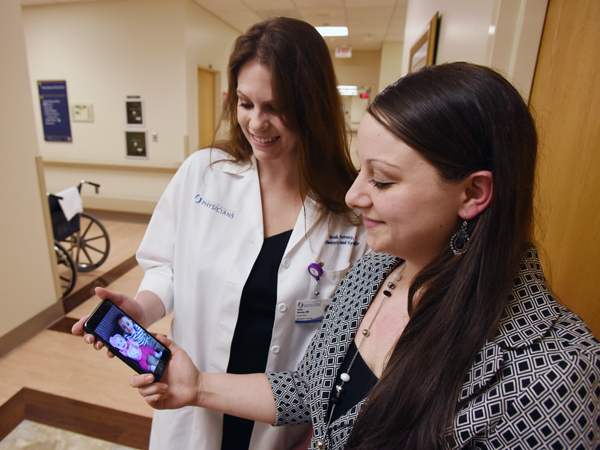UMMC clinicians, researchers tackle preeclampsia

Published in News Stories on May 21, 2015
Mississippi's health rankings commonly are among the worst in the nation, including percentages of children born prematurely and with low birth-weights.
But a possible treatment for one of the contributors to these statistics - preeclampsia - could come from the very state impacted the hardest by the condition.
"Preeclampsia is a disease that occurs in pregnancy and only in pregnancy," said Dr. Sarah Novotny, a maternal-fetal medicine specialist and assistant professor of obstetrics and gynecology at the University of Mississippi Medical Center. "It usually starts after 20 weeks gestation, and in the worst cases, it can lead to eclampsia which is seizures."
Preeclampsia is more likely to occur in a patient who is pregnant for the first time and happens somewhere between 5-8 percent of all pregnancies, she added. It's more common in women with chronic hypertension prior to pregnancy, women with diabetes, and in women who are either very young or older going into pregnancy. Also, obesity increases the risk of preeclampsia.
"As you can see, we have a lot of risk factors here in Mississippi," said Novotny, adding the condition causes a significant portion of the state's pre-term birth rate. Nationwide about 15 percent of all premature births are due to preeclampsia.
"The only cure for preeclampsia is delivery, and unfortunately this means a premature delivery," said Novotny. "In some cases we can try to manage the mother conservatively and keep her pregnant, but usually the result of preeclampsia is the need for delivery."
Researchers at UMMC are working to develop another potential treatment option for patients, one that would allow expectant mothers to take blood pressure medicine that normally is disallowed because of the potential harm to the child.

Bidwell
"The big picture of what we're trying to do is use a drug carrier that we work with called elastin-like polypeptide or ELP to deliver drugs during pregnancy to prevent them from crossing the placenta and being exposed to the developing fetus," said Dr. Lee Bidwell, an assistant professor of neurology.
"We think this could have applicability in really anything. It could be used to keep drugs from getting to the baby, so potentially it's much more broadly applicable in terms of treating other things during pregnancy," said Bidwell.
Bidwell's research partner in this endeavor, Dr. Eric George, an assistant professor in physiology and biophysics at UMMC, has focused his career's research on preeclampsia.
"Mostly what we've been doing up to this point is figuring out how to dose it, where it goes, what organs does it go to, and the drug-carrier itself," said George.
The goal would be to extend pregnancy for as long as possible, said Bidwell. Getting an extra few weeks in gestation is beneficial for the baby's development.
George said some patients develop preeclampsia later during pregnancy, a condition that's typically less severe since the fetus is more developed. "The problem with the early onset preeclampsia is it becomes dangerous about the time the baby isn't quite developed enough to deliver," he said.
At that time, delivery is dangerous because of the child's condition and the potential for long-term effects later in life, said Bidwell.
"The idea is to extend the pregnancy by three or four weeks to allow for more fetal development," said Bidwell.

George
"We don't need to cure it to the point where we take them out to nine months," added George. "We just need to get them over the developmental hump."
The research process is one that demands time, a procedure lengthened by drug testing and approval methods that George and Bidwell say could take many more years before their research could become a new treatment for the condition.
For mothers like Nikki Cohran, this meant treatment options were limited when she learned she was dealing with preeclampsia.
At 26 weeks pregnant, Cohran passed out during her nursing shift at UMMC. It was her first pregnancy and the new mother-to-be had no idea she was at risk of preeclampsia.
On the night she passed out at work, Cohran said she was taken downstairs where clinicians were putting lines in her and connecting her to the monitor. It was then that she was given two choices: try to keep her baby in the womb for as long as possible, a process called conservative management, or to deliver the child before her condition worsened.

Deuce weighed 1 lb. 13 oz. at birth.
"I was at risk with the conservative management and so was the baby," she said. "We decided to go that route, but 18 hours later it wasn't up to us anymore. The doctors went ahead and took him."
Montrel "Deuce" Bloodsaw was born on May 23, 2012. He weighed 1 lb. 13 oz.
Cohran said it would be another three and half months before her baby boy could go home.
Though her son has asthma and eczema, he's otherwise healthy, a fact for which Cohran is grateful each day.

Nikki Cohran holds her son, Deuce, who was born just under 27 weeks.
Yet when she learned of her second pregnancy last year, the fear of going through the same experience was immediate, she said.
"I was about five weeks pregnant, and we saw Dr. Michelle Owens (UMMC maternal-fetal medicine specialist) and Dr. Novotny," said Cohran. "I started taking an aspirin a day. It's supposed to reduce your chances of preeclampsia about 20 percent."
Otherwise, Cohran said she kept everything else relatively the same but remained on watch for any of the symptoms to return.
During the last eight weeks of her pregnancy, Cohran said she would see Drs. Owen or Novotny each week. "I was admitted twice for a little scare, but the doctors were very cautious and promising. It was a good feeling to have a good team on my side this time."
Her daughter, Audrey Bloodsaw, was born without any complications. Weighing 5 lbs. 1 oz., the outcome was the polar opposite from just a few years earlier.
"She went home with me, and that was a different experience because my companion last time I went home was a breast pump and a box of Kleenex, not a bouncing baby boy as it should have been," said Cohran.
Understanding the symptoms of the condition and reporting them to a physician is key to getting an early start on handling the problem, said Novotny.
"It's really important to educate patients about the symptoms and tell them not to hide it," she said. "I don't want the mom to sit on a headache for three days and risk having eclampsia or a stroke because she knows if she tells me she has a headache she's going to have her child delivered."
Novotny said the medical field is learning more about long-term health consequences on patients with preeclampsia. The American Heart Association recently changed their recommendations for health screenings to primary care providers and cardiologists to inquire about women's pregnancy history.
"A woman who has had preeclampsia is four times more likely to have heart disease later in life, twice as likely to have a stroke," said Novotny. "And that stroke risk is even higher the earlier in pregnancy she had preeclampsia. If it occurred in less than 30 weeks, her lifetime risk of stroke is even higher than a patient who had preeclampsia at term."
For women who know they are at an increased risk of developing preeclampsia during pregnancy, Novotny said optimizing their weight, exercising regularly, controlling blood pressure and controlling lipids if they've got high cholesterol are beneficial.
"If we can optimize a woman's health and prevent a few cases of preeclampsia or even delay the onset of preeclampsia a little bit, we can really help that child in the long term."
Photos
 | #UMMCGrad15 From drug rep to D.M.D. High Resolution Medium Resolution Low Resolution |
 | High Resolution Medium Resolution Low Resolution |
 | High Resolution Medium Resolution Low Resolution |
 | Publications *Indicates Trainee *Gowey, M. A., *Stromberg, S., Lim, C. S. , & Janicke, D. M. (under review). The moderating role of body dissatisfaction in the relationship between ADHD symptoms and disordered eating in overweight and obese children. Received revise and resubmit in Children's Hea High Resolution Medium Resolution Low Resolution |
 | High Resolution Medium Resolution Low Resolution |
 | Current Research Projects Healthy Lifestyle Behaviors in Overweight Youth Study High Resolution Medium Resolution Low Resolution |


